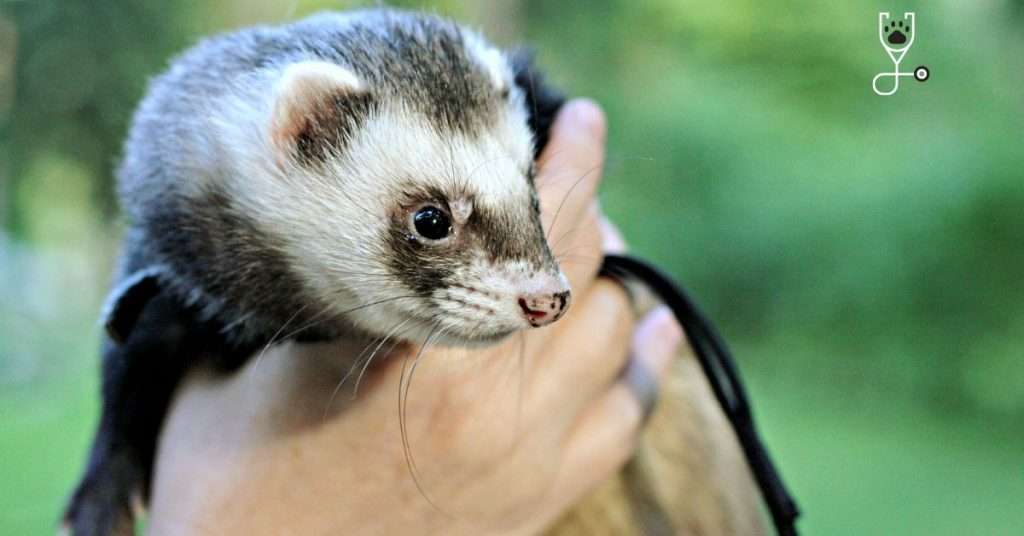Ferrets are known for their playful and curious nature, but did you know that some ferrets can be born with Waardenburg Syndrome? In this blog post, we’ll provide an overview of Waardenburg Syndrome in ferrets and what you need to know if you have a ferret with the disorder. Stay tuned for more information on this condition in future blog posts!

What Is Waardenburg Syndrome?
Waardenburg Syndrome (WS) is a rare congenital disorder that affects the pigmentation of an animal’s fur, eyes, and skin. The condition is caused by a mutation in the PAX3 gene and is characterized by white or light-colored patches of fur, blue eyes, and/or deafness. WS is found in many different species of animals, including humans, dogs, cats, horses, pigs, and ferrets.
While WS can occur in any color of ferret, it is most commonly seen in albino ferrets. Albino ferrets lack the pigment melanin in their fur, skin, and eyes. As a result, they have white or very light-colored fur and pink skin. They may also have blue eyes. WS is responsible for about 50% of all albino ferrets.
Approximately 1 in every 3,000 ferrets is born with WS. The disorder is thought to be more common in certain lines of ferrets, such as those used in breeding programs for the albino color pattern.
Read More: A Guide to Caring and Legally Owning for a Pet Otter
What Are the Signs of Waardenburg Syndrome in Ferrets?
The most common sign of WS in ferrets is white or light-colored patches of fur. These patches are usually symmetrical, meaning they occur on both sides of the body. The patches may be small or large, and they may be scattered randomly or grouped together in a specific area.
Other signs of WS in ferrets include blue eyes and/or deafness. Ferrets with WS may have one or both of these signs. Blue eyes are caused by the lack of pigment in the iris, which allows light to reflect off the blood vessels in the eye and give it a blue appearance. Deafness occurs when there is a problem with the development of the auditory nerve, which connects the ear to the brain.
WS is a congenital disorder, which means that it is present at birth. Ferrets with WS will typically show signs of the condition from a young age.

How Is Waardenburg Syndrome Diagnosed?
WS is typically diagnosed based on clinical signs and breed history. A physical examination will be performed to look for the characteristic white or light-colored patches of fur. The eyes will also be examined for blue irises.
Genetic Test
If WS is suspected, a genetic test can be performed to confirm the diagnosis. This test looks for the mutation in the PAX3 gene that is responsible for the condition.
Read More: Do Finger Monkeys Make Good Pets?
How Is Waardenburg Syndrome Treated?
There is no specific treatment for WS, as it is a congenital disorder that cannot be cured. However, ferrets with WS can live normal, healthy lives with proper care.
If your ferret has WS, you will need to take special care to protect its eyes from sunlight. Ferrets with blue eyes are especially sensitive to sunlight and may develop eye problems if they are exposed to too much light. You can purchase sunglasses or eye patches for your ferret to wear when it is outdoors.
It is also important to have your ferret’s hearing tested regularly.

Deafness
Deafness is a common complication of WS, and early detection is important in order to prevent further damage to the auditory nerve. Your veterinarian can refer you to a specialist for hearing testing.
In some cases, ferrets with WS may also require special care for their skin. The lack of pigment in the skin can make ferrets more susceptible to sunburn and other skin problems. You may need to apply sunscreen to your ferret’s skin when it is outdoors, and you should monitor the areas of light-colored fur for any signs of irritation.
Read More: 15 Unique and Rare Exotic Pets
Final Reminder
The majority of ferrets with Waardenburg syndrome live relatively normal and healthy lives. However, their care may present a few challenges. For example, they may have difficulty hearing or may be completely deaf. As a result, they may startle easily and may not be able to respond to your calls. In addition, they may have trouble seeing in low light conditions. As a result, you will need to take extra care to ensure that your environment is safe and free from obstacles.
Despite these challenges, ferrets with Waardenburg syndrome are still capable of forming strong bonds with their caregivers and other ferrets. With a little patience and understanding, you can provide them with the loving home they deserve.